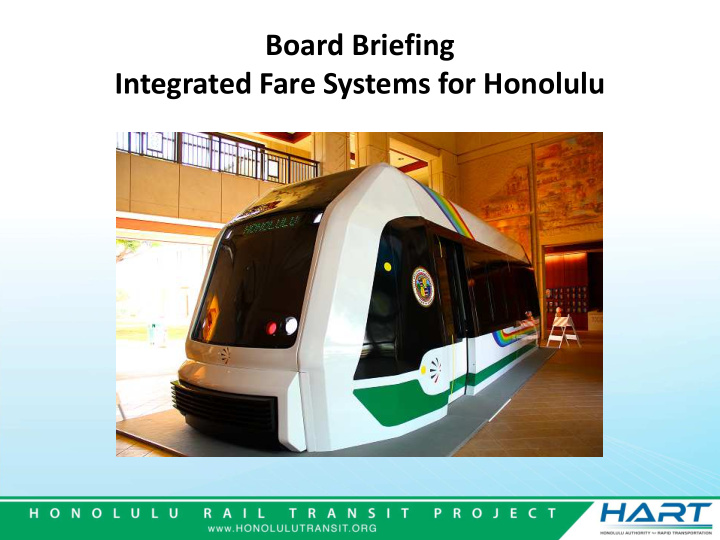



Board Briefing Integrated Fare Systems for Honolulu
Purpose Update Board on progress with Fare System for HART Overview of Fare System decision Overview of Integrated Transit Fare System for Oahu
Fare Systems Project Originally planned to purchase basic ticket vending machines to issue print tickets Concerns about fraud, integration and station safety with this approach arose Updated system allowed for: More convenient methods for purchasing tickets or passes; Better data about customers travel needs; Faregates to provide additional security in stations; Updated system that reduces fraud and provides for operational efficiencies
Participants for Fare System Design Multi-agency Steering Committee met beginning in Fall 2013 to March 2015 comprised of HART DTS/OTS BFS DIT Consultant: CH2M Hill HART Permitted Interaction Group I (“Group” = Bunda, Formby, Horner, Hui, Okinaga)
Project Goals by Steering Committee Design a simple and convenient fare collection system that operates seamlessly between modes Adopt proven fare technology based upon industry standards that reduces fraud and maximizes interoperability Enables enhanced data collection for improved customer service Increase distribution channels and fare purchasing options Increase participation in instructional programs and facilitate new transit partnerships e.g. bike share Minimize capital and operating costs
Board Involvement Meetings 4 Board Briefings (including PIG recommendation in October 2014) 4 Group Meetings Interagency Steering Committee determined optimal fare media and system options PIG I makes 2 main fare policy recommendations to the Board
Interagency Steering Committee made several key fare system determinations Smart card media Account based Open architecture These features provide: Security of proven IT architecture Transition path to new payment systems in the future Greatest potential for integration with Handi-Van and other non-transit services Potential for differential and location-specific fares Accommodates new payment systems in the future
PIG I Policy Recommendations Design of the fare collection system should plan for operations that maximize use of existing expertise and capacity at the City, OTS and HART HART’s fare collection system should include use of fare gates Both recommendations are intended to provide general direction, and are subject to further appropriation and budgeting decisions by the City and HART Today is an update to the Board on the status of these recommendations
Operations Strategy takes advantage of Existing Skills and Cost Efficiencies City/HART Program and Financial Management Central System Hosting (DIT) OTS Fare system call center Special Program/Retail Management Bus equipment maintenance
Honolulu Fare System will integrate Bus and Rail Closed loop, account based smart card system Cash will be accepted on board bus and at TVMs in rail stations Faregates at rail station entrances will only accept smart cards to enter Seamless transfer using smart card from bus to rail \rail to bus TVMs at all rail entrances (2 per entrance) TVMs also planned at major bus transfer locations
Fare System Architecture
How the System will Work- Getting a Card
How the System Will Work– Loading a Card
How the System Will Work- Using the Card
Bus equipment will be piloted first • Exiting farebox for cash collection will remain • Smart card target will be mounted before farebox with minimal driver interaction • Routers on board will allow for real time connection
Stations will be launched after bus service • Ticket Vending Machines (TVMs) • Faregates & Wheelchair ADA Access • Neighborhood & Station Locations Map • Customer Information Phones • Emergency Phones • Public Address and Digital Variable Messages • Directional Signage to Platform • Automated External Defibrillator (AED)
Faregates will be at all station entrances • Quantities determined based upon anticipated ridership and NFPA 130 • Also considers ADA requirements
Equipment will be service proven • Two TVMs at every entrance • TVMs will be ADA compliant • Intent is to have CCTV monitoring at the array
Recommend
More recommend